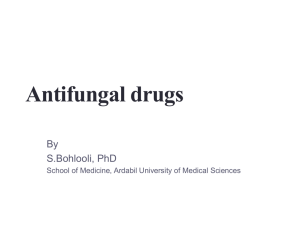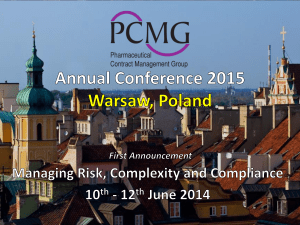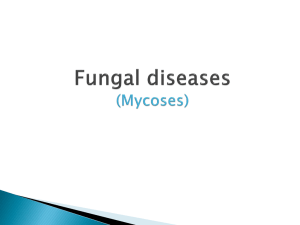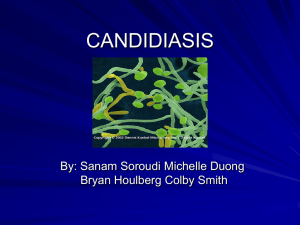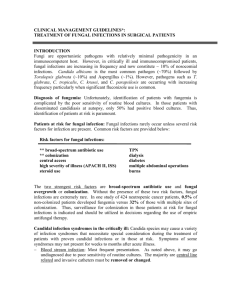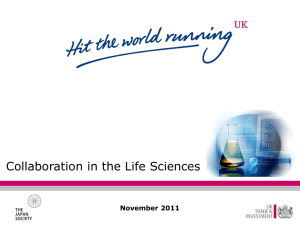DRAFT FOR REVIEW - Astellas Pharma US, Inc.
advertisement
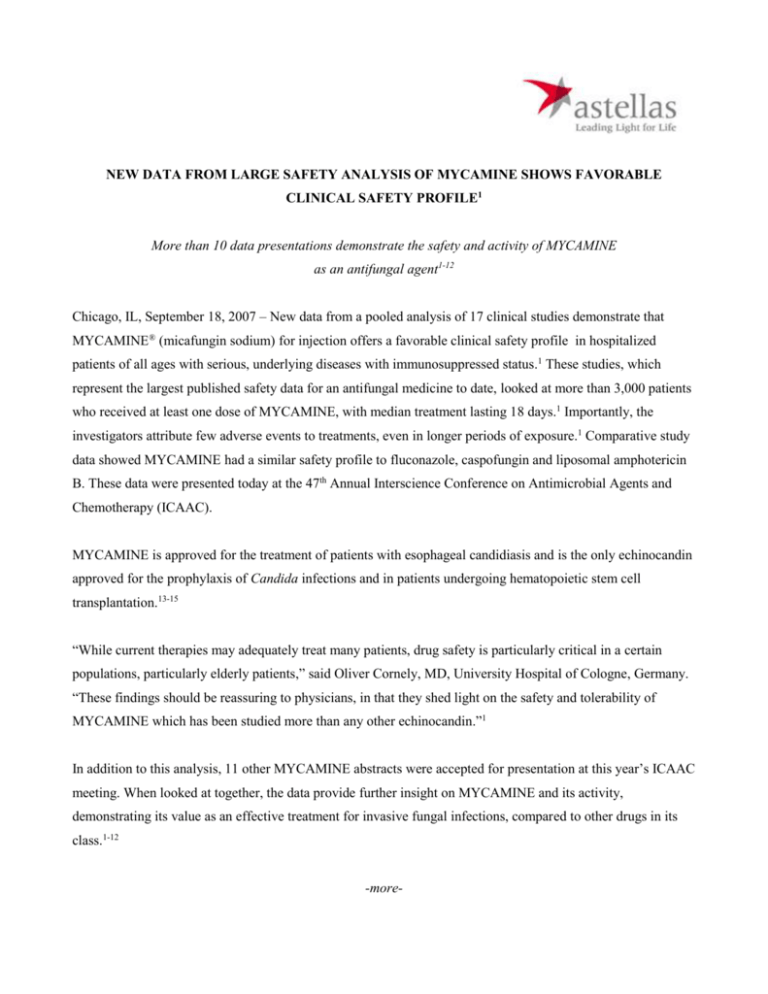
NEW DATA FROM LARGE SAFETY ANALYSIS OF MYCAMINE SHOWS FAVORABLE CLINICAL SAFETY PROFILE1 More than 10 data presentations demonstrate the safety and activity of MYCAMINE as an antifungal agent1-12 Chicago, IL, September 18, 2007 – New data from a pooled analysis of 17 clinical studies demonstrate that MYCAMINE® (micafungin sodium) for injection offers a favorable clinical safety profile in hospitalized patients of all ages with serious, underlying diseases with immunosuppressed status.1 These studies, which represent the largest published safety data for an antifungal medicine to date, looked at more than 3,000 patients who received at least one dose of MYCAMINE, with median treatment lasting 18 days.1 Importantly, the investigators attribute few adverse events to treatments, even in longer periods of exposure.1 Comparative study data showed MYCAMINE had a similar safety profile to fluconazole, caspofungin and liposomal amphotericin B. These data were presented today at the 47th Annual Interscience Conference on Antimicrobial Agents and Chemotherapy (ICAAC). MYCAMINE is approved for the treatment of patients with esophageal candidiasis and is the only echinocandin approved for the prophylaxis of Candida infections and in patients undergoing hematopoietic stem cell transplantation.13-15 “While current therapies may adequately treat many patients, drug safety is particularly critical in a certain populations, particularly elderly patients,” said Oliver Cornely, MD, University Hospital of Cologne, Germany. “These findings should be reassuring to physicians, in that they shed light on the safety and tolerability of MYCAMINE which has been studied more than any other echinocandin.”1 In addition to this analysis, 11 other MYCAMINE abstracts were accepted for presentation at this year’s ICAAC meeting. When looked at together, the data provide further insight on MYCAMINE and its activity, demonstrating its value as an effective treatment for invasive fungal infections, compared to other drugs in its class.1-12 -more- “Astellas has a history of commitment to the development of medicines that can change the way healthcare providers treat infectious disease,” said Nkechi Azie, MD, Medical Director, Medical Sciences, Astellas. “We are proud to see this number of micafungin studies at ICAAC and will continue to work collectively in the antiinfective community toward optimal treatment options for these patients.” Susceptibility Testing of Breakpoints with MYCAMINE Results from multiple studies were presented at ICAAC, illustrating the benefits of MYCAMINE in various populations and its activity as an antifungal agent. 1-12 Of the presented abstracts, the following is noteworthy as the first proposing susceptibility breakpoints of echinocandins, specifically MYCAMINE2,3: A Proposal for an Antifungal Susceptibility Testing (AST) Breakpoint of Micafungin and Candida: Integration of AST Surveys and Correlation with Clinical Outcomes In this study, investigators looked at two large, well-known medical databases to determine if candida isolates are more likely to be susceptible or resistant when exposed to MYCAMINE.2 The survey included more than 400 patients and 5700 isolates. 2 The analysis found candida isolates are more likely to be susceptible to MYCAMINE. 2 About the Safety Analysis This pooled analysis included data from 17 clinical trials of MYCAMINE conducted between 1998 and 2006, and looked at 3,028 patients from all age groups with severe and life-threatening underlying conditions, with approximately half of patients undergoing transplants or being treated for cancer. Patients in clinical studies with MYCAMINE have complex underlying conditions, such as cancer, HIV and hematopoetic stem cell transplantation and complications such as bacterial sepsis. Data are from 17 clinical studies in patients who received at least a single dose of MYCAMINE.1 Across all age groups, few adverse events were considered by the investigators to be treatment related, and no adverse events showed an increase incidence with a longer duration of exposure to MYCAMINE.1 No trends were seen with analysis of adverse events.1 Shifts in hepatic and renal laboratory values during treatment with MYCAMINE were consistent with the underlying condition of patients.1 About MYCAMINE MYCAMINE is a member of a newer class of antifungal agents, the echinocandins. MYCAMINE inhibits an enzyme essential for fungal cell-wall synthesis and is fungicidal (lethal) for Candida. -moreImportant Safety Information MYCAMINE is contraindicated in patients with hypersensitivity to any component of this product. Isolated cases of serious hypersensitivity (anaphylaxis and anaphylactoid) reactions (including shock) have been reported in patients receiving MYCAMINE. Isolated cases of clinically significant hepatic dysfunction, hepatitis, worsening hepatic failure, renal dysfunction, acute renal failure, hemolysis, or hemolytic anemia have occurred in some patients who have received MYCAMINE. Patients who develop these conditions, or abnormal liver or renal function tests, should be monitored for worsening function and evaluated for risk/benefit of continuing MYCAMINE therapy. Adverse events with MYCAMINE included mental confusion and possible histamine-mediated symptoms (including rash, pruritus, facial swelling, and vasodilatation). About Astellas Pharma US, Inc. Astellas Pharma US, Inc., located in Deerfield, Illinois, is a U.S. affiliate of Tokyo-based Astellas Pharma Inc. Astellas is a pharmaceutical company dedicated to improving the health of people around the world through the provision of innovative and reliable pharmaceutical products. The organization is committed to becoming a global category leader in focused areas by combining outstanding R&D and marketing capabilities. In the U.S., Astellas markets products in the areas of immunology, urology, anti-infectives, cardiovascular and dermatology. For more information about Astellas Pharma US, Inc., please visit our website at www.astellas.com/us. ### Media Contacts: Cohn & Wolfe Lindsey Minella 312-416-7728 Lindsey_minella@cohnwolfe.com Astellas Pharma US Inc. Corporate Communications Maribeth Landwehr 847-317-8988 maribeth.landwehr@us.astellas.com References: 1. Pooled Analysis of Safety for Micafungin. Cornely. Presentation September 18, 2007 2. Proposal for an Antifungal Susceptibility Testing (AST) Breakpoint for Micafungin with Candida: Integration of AST Surveys and Correlation with Clinical Outcomes. Ostrosky-Zeichner. Presentation September 20, 2007 3. Micafungin in Pediatric Patients: Assessment of Safety in Clinical Trials. Arrieta. Presentation September 18, 2007 4. Candida albicans (CA) Biofilm Activity of Flucytosine (F), Micafungin (M), and Liposomal Amphotericin B (L-AmB) in an In Vitro Model of Simulated Endocardial Vegetations. Pai. Presentation September 19, 2007 5. Pharmacokinetics of Micafungin in Adult patients with Invasive Candidiasis and Candidaemia. Kuse. Presentation September 18, 2007 6. Pharmacokinetics of Micafungin in Paediatric patients with Invasive Candidiasis and Candidaemia. Freire. Presentation September 18, 2007 7. Pharmacokinetics of Micafungin in HIV Positive Patients with Oesophageal Candidiasis (OEC). Baraldi. Presentation September 18, 2007 8. Trends of Culture Confirmed Candidaemia on Admission From 2000-2005: Analysis of 61,582 Culture Positive Blood Stream Infections. Shorr. Presentation September 18, 2007 9. Improved survival in experimental pulomary aspergillosis (PA) in combination with micafungin plus voriconazole: study of add-on, sequential or simultaneous treatment regimen. Matsumoto. Presentation September 19, 2007 10. Efficacy of Single-Dose Liposomal Amphotericin B or Micafungin Prophylaxis in a Persistently Neuropenic Murine Model of Invasive Pulmonary Aspergillosis (IPA). Lewis. Presentation September 19, 2007 11. A Multi-Site Evaluation of Two New Echinocandins, on the Sensititre® YeastOne® Test Plan Compared with the Frozen Reference CLSI M27 Microbroth Dilution Plate for Antifungal Susceptibility Testing. Knapp. Presentation September 17, 2007 12. Pharmacokinetics of an Elevated Dosage of Micafungin in Premature Neonates Smith. Presentation September XX, 2007 13. MYCAMINE [package insert]. Deerfield, IL: Astellas Pharma US, Inc; August 2007. 14. Cancidas [package insert]. Whitehouse Station, NJ: Merck & Co, Inc; 2005. 15. Eraxis [package insert]. New York, NY: Pfizer inc, 2007

